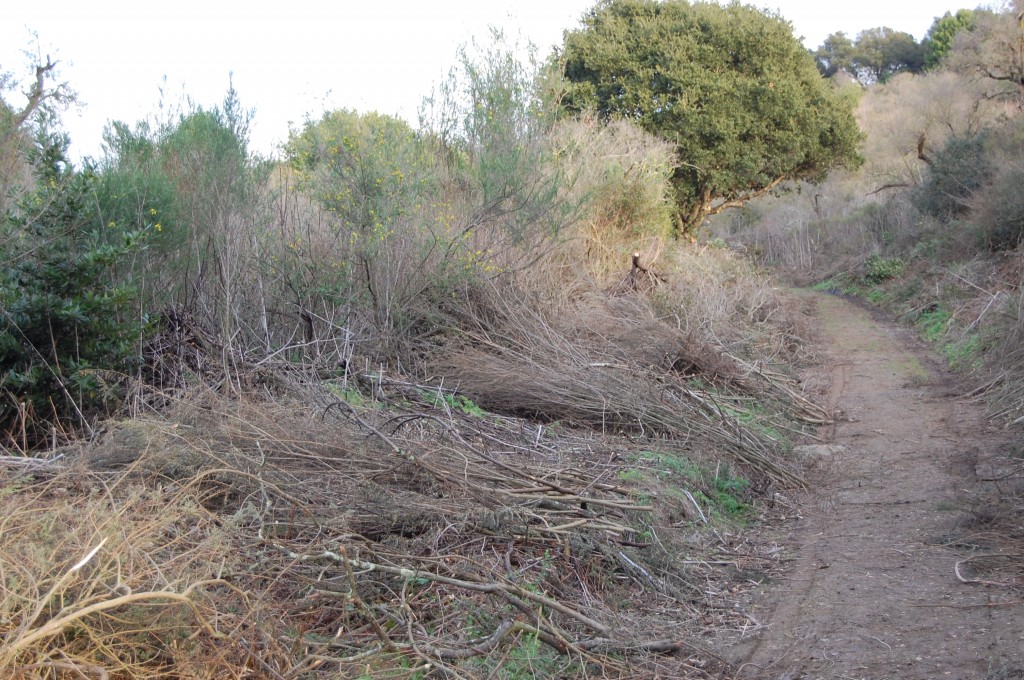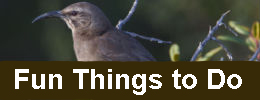Crews were out this past week cutting trees and shrubs in 15-foot swaths on either side of the fire roads leading into the park, creating habitat loss and the further invasion of weeds like french broom, poison hemlock, and thistles. (The accompanying photo shows native coastal scrub. The remaining yellow-flowering shrub on the left is french broom.) Assistant Fire Marshal Leroy Griffin stated that the work was necessary to maintain emergency access for fire engines.
We don’t doubt the need for emergency access in the service of public safety. What’s at issue here is whether the proper environmental review was performed, especially given that the work cut straight through known Alameda whipsnake habitat. Most of the vegetation removed was native scrub. Even more troubling is the City’s schizophrenic approach to the enforcement of public safety codes and its dismissal of appropriate environmental review.
As to the first cause, there’s a long history of lack of compliance with the California Environmental Quality Act. Residents in the hills passed a bond measure in 2004 that created the Wildfire Assessment District. Homeowners from approximately 20,000 residences pay $75 per parcel each year for fire services in the WAD. According to the language in the bond measure, a portion of those funds is to be used to produce an Environmental Impact Report analyzing impacts of vegetation management . But in the 8 years that the City has collected the money, no environmental analysis has been performed, giving the OFD carte blanche to cut, chop, and graze its way through habitat without ever having to consider the impacts or alternatives to protecting the environment from weed invasion as a result of the fuels projects.
Last year the Hills Emergency Forum, an association of cities, fire departments, and agencies in the East Bay hills that formed in the wake of the catastrophic 1991 Tunnel Fire, released its report, “Twenty Years After,” (http://www.hillsemergencyforum.org/docs/20yearsafter.pdf). It’s an update on progress made by member organizations in following a series of recommendations from 2001 on improving fire safety and simultaneously complying with environmental regulation.
One of the key recommendations focused on addressing whether its member organizations had completed their appropriate environmental compliance documents (required under the California Environmental Quality Act and/or the National Environmental Protection Act). Agencies such as the East Bay Regional Park District and the East Bay Municipal Utilities District have completed their Environmental Impact Reports. Oakland did not respond to this portion of the report (pg. 76).
Moreover, the City apparently decides what fire laws and guidelines to follow and which to ignore depending upon political expedience. So, while it may insist that public welfare and the law require that it widens the fire access roads, where was the deep concern for public safety when the City approved the zoo’s lunatic plan to place its proposed Interpretive Center at the very edge of the steep slopes of high hazard chaparral in Knowland Park?
The “Twenty Years After” report addressed political pressure to build in areas known to be Very High Fire Hazard Severity Zones especially those that create difficult access for firefighters. Key conditions that define these zones in the urban wildland interface are steep topography, high hazard vegetation, problematic access.
The zoo’s proposed Interpretive Center, a 33,000 sq. ft. building connected to the lowlands by an aerial gondola, is planned for one of the most dangerous sites imaginable. Surrounded by dozens of acres of chaparral and coastal scrub–rich, pristine wildlife habitat–the Interpretive Center would perch at the very edge of the slope while the gondola line would pass over the chaparral. In short a potential disaster waiting to happen but conveniently ignored, despite our repeated comments about the threats to public safety (the site is also in a state-defined high seismic hazard site).
Since Oakland Fire Department’s compliance standards for defensible space around buildings in Very High Fire Hazard Severity Zones allows up to 100 feet of vegetation clearance, the only apparent solution to protecting the Interpretive Center and its visitors from this self-imposed public safety threat is to cut down the chaparral–that’s the plan.The chaparral is an extremely rare plant community and together with the coastal scrub provides core Alameda whipsnake habitat and a critical link in a wildlife corridor that extends from Knowland Park all the way to San Leandro Reservoir. This corridor provides cover and safe passage for mountain lions, bobcat, and many other species which use Knowland Park.
Good alternatives exist to this kind of folly and terrible waste of a precious public resource. There are other excellent sites available for the Zoo to expand, yet, perversely, the City and Zoo persist in pressing for the worst possible plan.
So, here’s the choice: expensive, environmentally damaging dangerous projects or well-planned, safe, affordable, environmentally protective projects? Will the City ever come to its senses or will it follow yet another path to disaster? You can let your city council member know that you’re tired of the hypocrisy, and let the OFD (lgriffiin@oaklandnet.com) know that you want the Environmental Impact Report that you’ve paid for over the past 8 years.
Mayor Jean Quan
1 Frank H. Ogawa Plaza,
3rd Floor
Oakland CA 94612
Email: jquan@oaklandnet.com
Web ontact form: http://www.oaklandnet.com/contactmayor.asp
Chief of Staff Anne Campbell Washington
Phone: (510) 238-3141
Fax: (510) 238-4731
TTY: (510) 238-3254
Email: ACampbell-Washington@oaklandnet.com
Council District 1 – Jane Brunner
1 Frank H. Ogawa Plaza, 2nd Floor
Oakland, CA 94612
Phone: (510) 238-7001
Fax: (510) 238-6910
Email: jbrunner@oaklandnet.com
Council District 2 – Patricia Kernighan
1 Frank Ogawa Plaza, 2/F
Oakland, CA 94612
Phone: (510) 238-7002
Fax: (510) 238-6910
Email: pkernighan@oaklandnet.com
Council District 3 – Nancy Nadel
One Frank Ogawa Plaza, 2nd Floor
Oakland, CA 94612
Phone: (510) 238-7003
Fax: (510) 238-6129
Email: nnadel@oaklandnet.com
Council District 4 – Libby Schaaf
1 Frank H. Ogawa Plaza
Oakland, CA 94612
Phone: (510) 238-7004
Email: lschaaf@oaklandnet.com
Council District 5 and Vice Mayor – Ignacio De La Fuente
1 Frank H. Ogawa Plaza
Oakland, CA 94612
Phone: (510) 238-7005
Fax: (510) 238-6129
Email: idelafuente@oaklandnet.com
Council District 6 – Desley Brooks
1 Frank Ogawa Plaza
Oakland, CA 94612
Phone: (510) 238-7006
Fax: (510) 238-6910
Email: dbrooks@oaklandnet.com
Council District 7 and Council President – Larry Reid
1 Frank Ogawa Plaza
Oakland, CA 94612
Phone: (510) 238-7007
Fax: (510) 238-6910
Email: lreid@oaklandnet.com
Councilmember At Large – Rebecca Kaplan
1 Frank H. Ogawa Plaza
Oakland, CA 94612
Phone: (510) 238 – 7008
Email: atlarge@oaklandnet.com
 Laura Baker is an environmental activist and former conservation chair of the East Bay Chapter of the California Native Plant Society. She holds an MA in ecology and systematic biology. Growing up in Missouri, she learned early that the cure for most ills rests in spending time out in nature. She wishes for every child to have the experience of wholeness that nature provides.
Laura Baker is an environmental activist and former conservation chair of the East Bay Chapter of the California Native Plant Society. She holds an MA in ecology and systematic biology. Growing up in Missouri, she learned early that the cure for most ills rests in spending time out in nature. She wishes for every child to have the experience of wholeness that nature provides.
Laura’s Knowlander blog is dedicated to building an online library of the natural history of Knowland Park so that the public may enjoy the park for the natural heritage treasure that it is. Knowing the land is a never ending process of inquiry open to all. We welcome your comments, contributions, and photos.

 Follow
Follow







